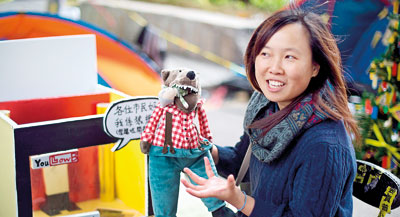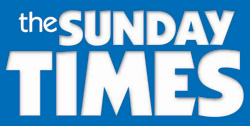Sunday Times 2
Wordplay a new weapon in Hong Kong democracy battle
HONG KONG (AFP) – In street tents, on stages and online, Hong Kong’s young demonstrators express themselves in an emerging dialect that is evolving so rapidly Helen Fan decided to deploy a new weapon in the democracy fight: a dictionary.
The soft-spoken artist is one of a group of protesters behind Umbrella Terms, an online glossary in English and Cantonese of the hundreds of slogans, phrases and symbols that have emerged since September, when students took to the streets in a defiant call for free elections.

Artist Helen Fan, one of the founders of an online glossary Umbrella Terms, gestures while holding a 'Lufsig', a toy wolf used as a symbol of opposition to the government and chief executive Leung Chun-ying who is nicknamed 'the wolf', at the main Admiralty protest site in Hong Kong. In street tents, on stages and online, Hong Kong's young demonstrators express themselves in an emerging dialect that is evolving so rapidly Helen Fan decided to deploy a new weapon in the democracy fight: a dictionary. AFP
“It is really an explosion,” Fan, 29, says. The vibrant patois includes derogatory puns on the name of the vilified city leader to tongue-in-cheek calls for action against Beijing’s ruling that leadership candidates must be vetted. “There are new terms appearing every week,” she says.
Academics say the so-called Umbrella Movement — named after the symbol of the pro-democracy protests — has given Cantonese new life.
This comes in the face of fears it could suffer the same fate as other regional languages such as Shanghainese, which are in gradual decline after decades of being subjugated to the official mainland language, Mandarin.
The Chinese government dismisses Cantonese, which is spoken by at least 60 million people worldwide, as a “dialect”.
“The current protest movement is reversing the negative impact of those (Beijing-imposed) educational policies on Cantonese and thrusting it into a key role in the political lives of the people,” says Victor Mair, Professor of Chinese Language and Literature at the University of Pennsylvania.
“There is really no precedent for what is happening in Hong Kong now,” he says.
The inventive language of the protesters adds to what is already a barrier of understanding for Beijing, which took control of the former British colony in 1997.
“Mandarin speakers can usually understand next to no spoken Cantonese and have a very difficult time making sense of full-blown written Cantonese,” says Mair.
“When you add in all of these new political puns and special idioms, then it becomes all the more difficult for outsiders to understand what Cantonese are saying and writing to each other,” he says.
New optimism
Chinese languages lend themselves to puns and veiled symbolism: the vast number of same-sounding words makes wordplay a gift, while characters with similar tones, or pitch patterns, can be easily switched to effect shifts in meaning.
When Hong Kong protesters talk about “going shopping” — “gau wu” — they mean “to occupy the streets in protest”.
It is a playful corruption of “gou wu” – the Mandarin for shopping — that incorporates “gau”, a vulgar colloquialism for male genitalia.
The phrase went viral after chief executive Leung Chun-ying advised protesters in the newly cleared Mong Kok district to “go shopping” to help local stores.
“Cantonese speakers have created the expression ‘gau wu’ to sardonically mimic the Putonghua (standard Mandarin) expression as a form of political protest,” says Professor Robert Bauer of the University of Hong Kong.
At the main Admiralty protest camp, toy wolves point to a play on the leader’s surname, which in Cantonese sounds like “long”, or “wolf”. A sign bears characters pronounced “si wai leung”, homophones for CY Leung meaning “Leung’s twisted thinking”.
Camps are referred to as villages — with a chorus of “the villagers think otherwise”, thought to have originated in a protest in a village in Hong Kong’s New Territories.
And beneath papered-over street signs pointing to social change, flimsy tents are distinguished by grand addresses such as Umbrella Court or Democracy Gardens.
The regal names parody those wealthy property developers give to luxury flats, a visible reminder of searing inequality in the cramped city.
Silas Fong, a Hong Kong-born artist living in Germany, designs tote bags bearing slogans in Cantonese — from well-worn slang to internet-age memes — as a form of “soft protest”.
“I was a bit worried about the disappearance of Cantonese. But after the Umbrella movement I turned optimistic about it,” Fong says.
Know your battlefield
Protests often evolve their own code, from a series of hand signals used at Occupy Wall Street in New York in 2011, to the Arab Spring, where rhyming couplet chants were shouted across national borders and a colloquial written Arabic gained currency online.
As well as phrases driven by rapid sharing on social media and chat apps such as Whatsapp, Umbrella Terms includes technical definitions on governance and civil rights.
“I realised I actually didn’t know many of the terms. No matter how passionate we are, or how often we share news on Facebook, if we don’t know our battlefield, then I think we cannot really move forward,” Fan says.
With students now discussing retreat from the protest sites and clearance orders being enforced, glossary co-founder Lesley Cheung, 20, hopes her work will preserve the legacy of an extraordinary time.
“For a long time I have been thinking, how can this momentum be infused into everyday life so that people in the future will no longer be so obedient, that they can easily mobilise a lot of people to fight against government policy,” she says.

